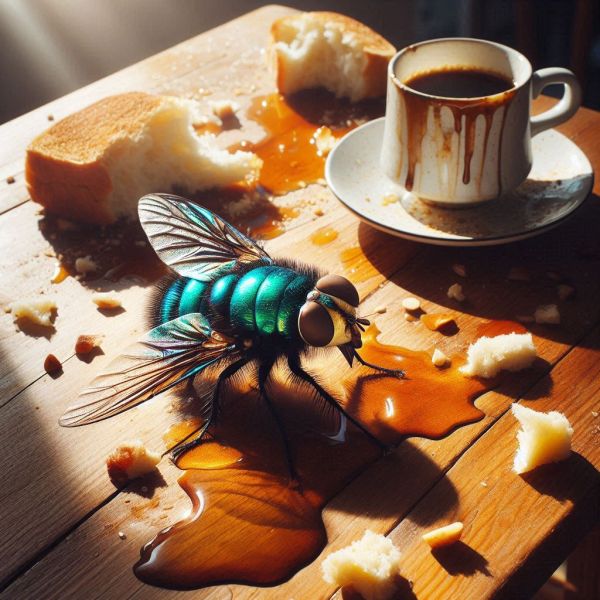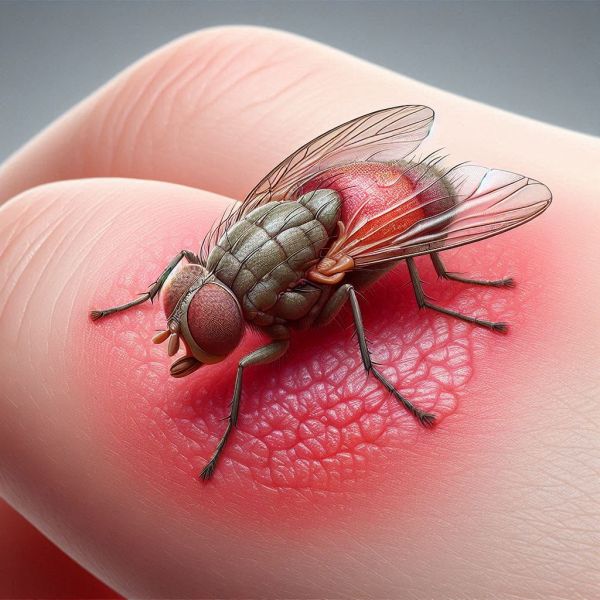
Did you know a lot about fly bites? It is Important about fly bites and their dangers.
- 1 What a fly bite looks like and why it is dangerous
- 2 Important information about fly bites: which flies bite
- 3 Horsefly
- 4 Botflies
- 5 Autumn Horseflies
- 6 Gnats (Midges)
- 7 Tsetse Fly
- 8 Why flies bite
- 9 Important information about fly bites and their dangers.
- 10 Is a fly bite dangerous?
- 11 What to do if bitten by a fly?
- 12 Interesting facts about flies:
What a fly bite looks like and why it is dangerous
Flies are as much a part of human life as cats or dogs. There are a large number of species. Horseflies and botflies are also flies.
It is practically impossible to count the exact number of flies in the world, as their population is constantly changing. This depends on climatic conditions, the season, natural disasters, and other factors. However, there are about 100,000 species.
Flies live everywhere—from deserts to tundras. There are countless of them. Some are harmless but annoying, while others are dangerous bloodsuckers. They are carriers of serious diseases.

Unlike houseflies, bloodsuckers have a true stinger instead of a soft proboscis – it is hard and sharp, like a dagger. In some, it resembles a drill with many attachments. At the end of this stinger are powerful chitinous plates, which are essentially the mouth of bloodsucking flies.
Important information about fly bites: which flies bite
Not all flies bite, only those whose mouthparts have a modified proboscis capable of piercing the skin of humans or animals. These are bloodsucking flies. They are not very common in the city, but people are well acquainted with them in rural areas.
Horsefly
Horseflies are a family of dipterous insects with a robust body, ranging from 0.7 to 3 cm in size, with transparent or spotted wings. There are nearly 4,500 species, from the smallest golden-eyed horsefly with bright coloring to the dangerous horsefly. The most widespread in the world is the red-faced horsefly, which lives on almost all continents.
Male horseflies are harmless; they feed on nectar. Only females bite, and their saliva contains an enzyme that blocks blood clotting, making the bite very painful.
Botflies
Botflies are not very large creatures, with bodies ranging from 0.9 to 2 cm, but they are dangerous. Only females sting. Warm-blooded mammals serve as living incubators for them, as the female botfly attempts to lay her eggs under the skin. Domestic livestock suffers the most from botflies, as their grazing areas attract swarms of flies. The lifespan of a botfly is short—at most a month.
The main difference between botflies and horseflies is that horseflies are bloodsuckers, while botflies are not. However, botflies are carriers of filariasis, anthrax, and tularemia.
Autumn Horseflies
Autumn horseflies got their name due to the burning pain caused by their bite. Their saliva, like that of horseflies, prevents blood clotting. They bite in a true sense—scraping the skin with powerful, sharp, blade-like chitinous teeth at the tip of a hard, wedge-shaped proboscis. An inflammatory process begins at the site of the bite.
Externally, horseflies resemble common flies. However, their wings are wider, and their proboscis is longer and extended forward. Both males and females bite. Bites, especially multiple ones, are dangerous for humans and animals. They are carriers of tularemia, salmonellosis, brucellosis, and anthrax, and can cause sepsis.
Gnats (Midges)
For female midges, humans and animals are blood donors, which these insects need to lay their eggs. They are small, measuring only 2-4 mm in length, with a pair of wings and short legs.
Their saliva, on one hand, causes numbness in the bitten area, while on the other hand, it acts as an anticoagulant, and thirdly, it contains toxins that cause swelling, itching, and allergic reactions, and can even lead to anaphylactic shock. Midges are carriers of serious diseases. For example, gnats from certain regions of America and Africa spread onchocerciasis (river blindness). Bites itch for a long time, making them dangerous as they can lead to secondary infections.
Tsetse Fly
The most dangerous biting fly species in the world. They inhabit Africa and the Arabian Peninsula. Their sting is a drilling-type proboscis. The body size ranges from 0.6 to 1.5 cm.
They have an aggressive temperament. The tsetse fly attacks any moving object that emits heat, even cars. Interestingly, the only ones that are not bitten by tsetse flies are zebras. Their natural camouflage – black and white stripes – disorients tsetse flies. The insects cannot estimate the distance to the landing site and as a result circle without landing.
Tsetse flies are very dangerous for humans and animals. They are carriers of trypanosomiasis, or sleeping sickness. This is manifested by high fever, difficulty breathing. Often leads to nervous system disorders and loss of sleep, which can lead to death. Each year, about 500,000 people die from the consequences of tsetse fly bites.
With a single bite, this small insect can suck more blood from its victim than it weighs itself. The tsetse fly does not lay eggs; it gives birth to one larva at a time. The tsetse fly is viviparous.
Why flies bite
There are two reasons why flies bite, both related to offspring.
In the first case, blood serves as food, which means the possibility of continuing the species.
In the second case, it provides an environment for laying eggs under the skin of living beings, as well as nourishment and development for the larvae.
Flies become especially dangerous in late summer and early fall.
As their life cycle comes to an end and it is time to lay their young.
August is the peak time for fly reproduction. Moreover, natural food sources (fruits, flower nectar) are depleted, and hunger does not go away.
Important information about fly bites and their dangers.
A fly bite often looks like a mosquito bite, but it can resemble a scratch with a bump of swelling and inflammation around it. The appearance of the affected area and the symptoms of clinical manifestations depend on the type of fly. Also on the individual reaction of a person to its toxins.
In small children, allergy sufferers, and people with weakened immune systems, inflammation of the lymph nodes and the formation of an ulcer at the site of the bite may occur.
Is a fly bite dangerous?
Yes, it is dangerous. Firstly, it is painful and unpleasant, and it can cause an allergic reaction. If you are bitten by a horsefly, it is advisable to see a doctor. Additionally, flies carry numerous types of infections. Pathogenic microorganisms can survive for a long time in the saliva of flies. Then they enter the human bloodstream when bitten.
It is important to remember the danger of fly bites for people with weakened immune systems. Also people with chronic diseases, the elderly, children and pregnant women.
Diseases carried by flies include:
- salmonellosis,
- cholera,
- hepatitis,
- anthrax,
- dysentery,
- filariasis,
- typhoid fever,
- malaria,
- trypanosomiasis,
- sepsis,
- anaplasmosis,
- tularemia,
- brucellosis,
- poliomyelitis,
- sleeping sickness,
- tuberculosis
- secondary bacterial infections arising from contamination of wounds.
And this is not a complete list. These are just the most common consequences of fly bites.
What to do if bitten by a fly?

Most often, we react to a fly bite with a local reaction: the bite site swells, turns red, and itches. However, reactions affecting internal organs or a strong immune response of the body are also possible.
Especially in the case of multiple bites.
This can manifest as hives, pus formation, increasing swelling, elevated body temperature, which needs to be measured with a thermometer.
Here’s what you should do first if you are bitten by a fly:
- Wash the bite area with water. Treat with an antiseptic (chlorhexidine, alcohol), apply a special ointment to relieve itching. Then cover with a breathable bandage or plaster.
- If you are prone to allergies, take an antihistamine immediately.
- If swelling and the area of inflammation increase, if an allergic reaction occurs, if there is a rise in temperature, pus formation in the wound, or symptoms of poisoning appear, you should seek medical help.
- Do not scratch the bite area to avoid the risk of a secondary infection.
- If after 3-5 days you experience drowsiness, dehydration, dizziness, and fever, consult a doctor. If the fly has laid larvae under the skin, the sensations may resemble poisoning. Medical intervention will be required to remove the larvae.
Interesting facts about flies:
- The taste receptors of flies are located on the pads of their feet. That’s why they often rub their feet together.
- A fly’s eyes consist of several thousand segments and can distinguish not only familiar colors but also ultraviolet light.
- A single housefly can lay up to 3,000 eggs during its life cycle, which lasts about a month.
- Mayflies live for less than a day.
- Common houseflies do not bite. They can only lick food with their soft proboscis. The flies that bite are similar in appearance but are more armored – they are called horseflies.